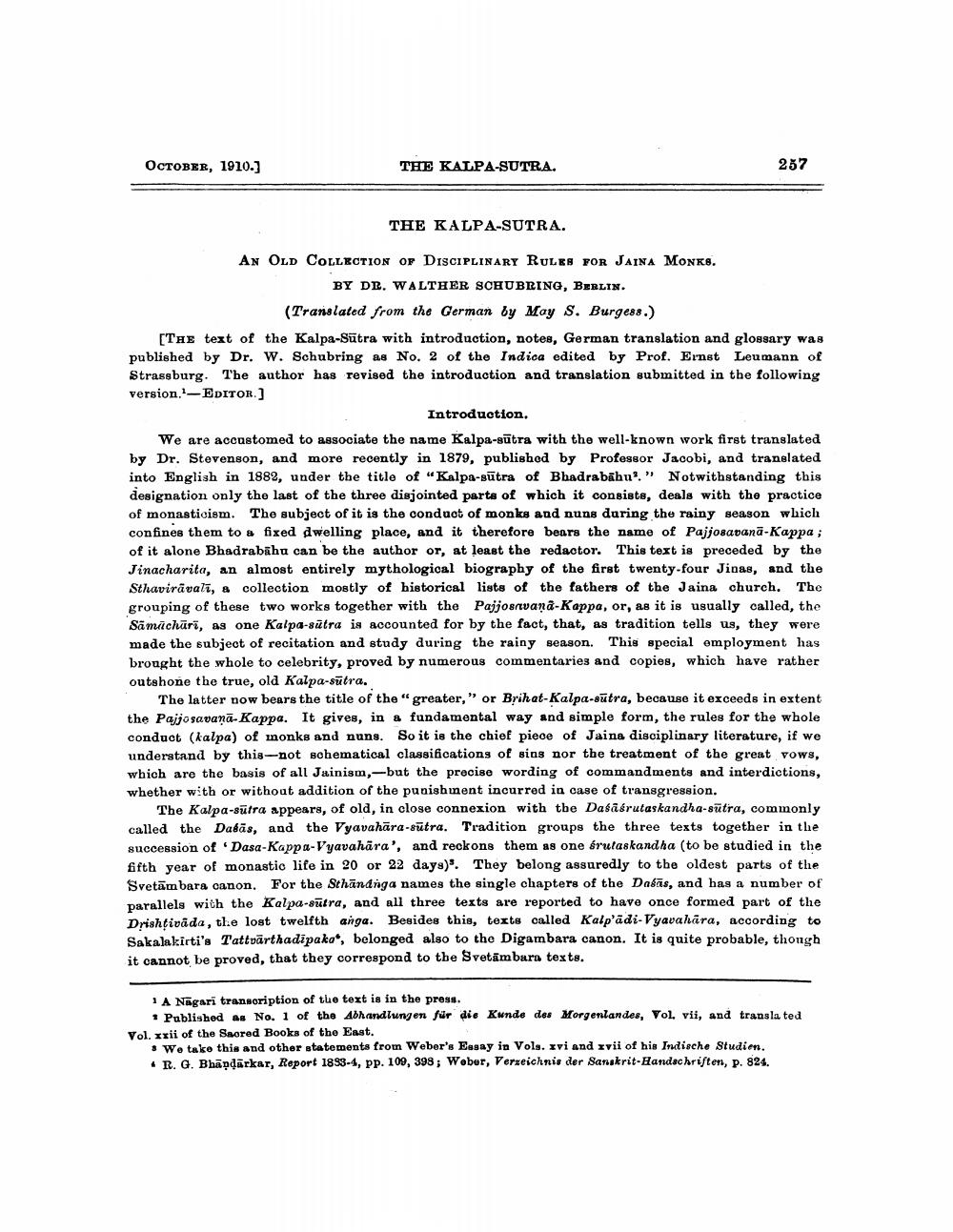________________
OCTOBER, 1910.)
THE KALPA-SUTRA.
257
THE KALPA-SUTRA.
AN OLD COLLECTION OF DISCIPLINARY RULES FOR JAINA MONKS.
BY DR. WALTHER SCHUBRING, BERLIN.
(Translated from the German by May S. Burgess.) [TAE text of the Kalpa-Sūtra with introduction, notes, German translation and glossary was published by Dr. W. Schubring as No. 2 of the Indica edited by Prof. Ernst Leumann of Strassburg. The author has revised the introduction and translation submitted in the following version. -- EDITOR.]
Introduction, We are accustomed to associate the name Kalpa-sūtra with the well-known work first translated by Dr. Stevenson, and more recently in 1879, published by Professor Jacobi, and translated into English in 1882, under the title of "Kalpa-sūtra of Bhadrababu'." Notwithstanding this designation only the last of the three disjointed parts of which it consists, deals with the practice of monasticism. The subject of it is the conduct of monks and nuns during the rainy season which confines them to a fixed dwelling place, and it therefore bears the name of Pajjosavanā-Kappa ; of it alone Bhadrabāhu can be the author or, at least the redactor. This text is preceded by the Jinacharita, an almost entirely mythological biography of the first twenty-four Jinas, and the Sthavirävalī, a collection mostly of historical lists of the fathers of the Jaina church. The grouping of these two works together with the Pajjosavana-Kappa, or, as it is usually called, the Sāmāchūri, as one Kalpa-sūtra is accounted for by the fact, that, as tradition tells us, they were made the subject of recitation and study during the rainy season. This special employment has brought the whole to celebrity, proved by numerous commentaries and copies, which have rather outshone the true, old Kalpa-sūtra.
The latter now bears the title of the "greater,” or Brihat-Kalpa-sūtra, because it exceeds in extent the Pajjosavanā-Kappa. It gives, in a fundamental way and simple form, the rules for the whole conduct (kalpa) of monks and nuns. So it is the chief piece of Jaina disciplinary literature, if we understand by this-not schematical classifications of sins nor the treatment of the great vows, which are the basis of all Jainism,-but the precise wording of commandments and interdictions, whether with or without addition of the punishment incurred in case of transgression.
The Kalpa-sūtra appears, of old, in close connexion with the Daśāśrutaskandha-sutra, commonly called the Dabās, and the Vyavahāra-sūtra. Tradition groups the three texts together in the succession of Dasa-Kappa-Vyavahāra', and reckons them as one śrutaskandha (to be studied in the fifth year of monastic life in 20 or 22 days)". They belong assuredly to the oldest parts of the Svetām bara canon. For the Sthānanga names the single chapters of the Datās, and has a number of parallels with the Kalpa-sūtra, and all three texts are reported to have once formed part of the Drishtivada, the lost twelfth anga. Besides this, texts called Kalp'ādi-Vyavahāra, according to Sakalakirti's Tattvärthadipaka", belonged also to the Digambara canon. It is quite probable, thongh it cannot be proved, that they correspond to the Svetambura texts.
IA Nügari transcription of tue text is in the press.
Published as No. 1 of the Abhandlungen für die Kunde des Morgenlandes, Vol. vii, and translated Vol. xxii of the Sacred Books of the East.
We take this and other statements from Weber's Essay in Vols. xvi and xvii of his Indische Studien. + R. G. Bhandarkar, Roport 1893-4, pp. 109, 398; Wobur, Verzeichnis der Sanskrit-Handschriften, p. 824.




